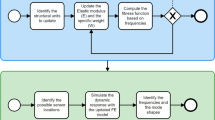Abstract
The Shanghai Tower, currently being constructed in Shanghai, China, is a supertall building with a height of 632 m. The Shanghai Tower will be the tallest skyscraper in China after its completion. This structure consists of a core wall inner tube, an outer mega-frame, and a total of six levels of outriggers that connect the tube and the frame. The structure needs comprehensive full-scale investigation to understand its structural performance when subjected to dead loads, strong winds, earthquakes, and temperatures, given its supertall height and complex structural configuration. A sophisticated structural performance monitoring system that consists of more than 400 sensors is designed for both in-construction and in-service real-time monitoring of the skyscraper. This paper reports the structural system and provides details on the performance of the monitoring system. The key features of the monitoring system are the following: (1) simultaneous installation of sensors and data acquisition systems with structural construction to record initial values; (2) measurement of structural settlement and displacement at different construction stages; (3) direct measurement of wind loads on structure facades through 27 wind pressure sensors; (4) measurement of structural inclination and derivation of structural sway at different heights using 40 inclinometers. Preliminary monitoring data, which include deformation and strain/stress up to the present construction stage, are also presented and discussed.
















Similar content being viewed by others
References
Aktan AE, Catbas FN, Grimmelsman KA, Tsikos CJ (2000) Issues in infrastructure health monitoring for management. J Eng Mech ASCE 126(7):711–724
Brownjohn JMW, Pan TC (2008) Identifying loading and response mechanisms from ten years of performance monitoring of a tall building. J Perform Constr Facil ASCE 22(1):24–34
Brownjohn JMW, Pan TC, Cheong HK (1998) Dynamic response of Republic Plaza, Singapore. Struct Eng 76(11):221–226
Ding JM, Zhao X, Chao S (2010) The Shanghai Tower. In: Conference on structural marvels, Singapore, 13–14 Dec
GB 50010 (2002) Code for design of concrete structures. National Standard of People’s Republic of China, Beijing (in Chinese)
Huang MJ (2006) Utilization of strong-motion records for post-earthquake damage assessment of buildings. In: Proceedings of the international workshop on structural health monitoring and damage assessment, Taichung, Taiwan, 14–15 Dec, pp IV1–IV29
Huang MJ, Shakal AF (2001) Structure instrumentation in the california strong motion instrumentation program. Strong Motion Instrum Civil Eng Struct 373:17–31
Kijewski-Correa T, Kareem A (2003) The Chicago monitoring project: a fusion of information technologies and advanced sensing for civil infrastructure. In: Wu ZS, Abe M (eds) Structural health monitoring and intelligent infrastructure. Balkema, Lisse, pp 1003–1010
Kijewski-Correa T, Kilpatrick J, Kareem A, Kwon DK, Bashor R, Kochly M, Young BS, Abdelrazaq A, Galsworthy J, Isyumov N, Morrish D, Sinn RC, Baker WF (2006) Validating wind-induced response of tall buildings: synopsis of the Chicago full-scale monitoring program. J Struct Eng (ASCE) 132(10):1509–1523
Ko JM, Ni YQ (2005) Technology developments in structural health monitoring of large-scale bridges. Eng Struct 27:1715–1725
Li QS, Fang JQ, Jeary AP, Wong CK, Liu DK (2000) Evaluation of wind effects on a supertall building based on full-scale measurements. Earthq Eng Struct Dynam 29:1845–1862
Li QS, Wu JR, Liang SG, Xiao YQ, Wong CK (2004) Full-scale measurements and numerical evaluation of wind-induced vibration of a 63-story reinforced concrete tall building. Eng Struct 26:1779–1794
Li QS, Xiao YQ, Fu JY, Li ZN (2007) Full-scale measurements of wind effects on the Jin Mao Building. J Wind Eng Ind Aerodyn 95:445–466
Lin CC, Wang CE, Wang JF (2003) On-line building damage assessment based on earthquake records. In: The first international conference on structural health monitoring and intelligent infrastructure, Tokyo, Japan, 13–15 Nov, pp 551–559
MIDAS GEN (2012) Analysis manual for MIDAS/GEN. MIDAS Information Technology Co. Ltd., Seoul, Korea
Ni YQ, Wong KY, Xia Y (2011) Health checks through landmark bridges to sky-high structures. Adv Struct Eng 14(1):103–119
Ni YQ, Xia Y, Liao WY, Ko JM (2009) Technology innovation in developing the structural health monitoring system for Guangzhou New TV Tower. Struct Control Health Monit 16(1):73–98
Sohn H, Farrar CR, Hemez FM, Shunk DD, Stinemates DW, Nadler BR, Czarnecki JJ (2004) A review of structural health monitoring literature form 1996–2001. Los Alamos National Laboratory report LA-13976-MS
Xia Y, Ni YQ, Zhang P, Liao WY, Ko JM (2011) Stress development of a super-tall structure during construction: field monitoring and numerical analysis. Comput Aided Civil Infrastruct Eng 26(7):542–559
Xu YL, Xia Y (2012) Structural health monitoring of long-span suspension bridges. Spon Press, London
Acknowledgments
This work is jointly supported by the Research Grants Council of the Hong Kong Special Administrative Region, China (Project No. PolyU 5285/12E) and the Hong Kong Construction Industry Institute/PolyU Innovation Fund (Project No. 5-ZJD3).
Author information
Authors and Affiliations
Corresponding author
Rights and permissions
About this article
Cite this article
Su, JZ., Xia, Y., Chen, L. et al. Long-term structural performance monitoring system for the Shanghai Tower. J Civil Struct Health Monit 3, 49–61 (2013). https://doi.org/10.1007/s13349-012-0034-z
Received:
Revised:
Accepted:
Published:
Issue Date:
DOI: https://doi.org/10.1007/s13349-012-0034-z




